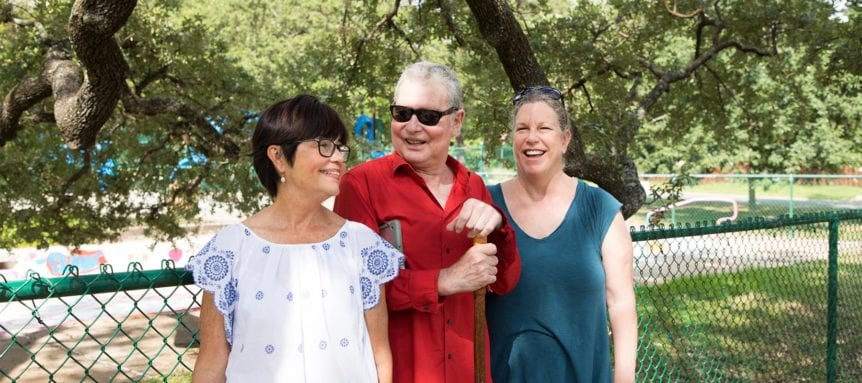By Elizabeth McGuire
In one of the oldest neighborhoods in Austin, a team of stewards is working to preserve their park and to inspire others to follow suit in their own neighborhoods. Three leaders of Friends of Shipe Park—Jill Nokes, Alison Young and Mark Fishman—have worked with Austin Parks Foundation and countless volunteers to keep Shipe a vibrant, healthy, resilient park.
All three longtime Austinites live within blocks of the historic Hyde Park greenspace. The park is situated in a unique urban setting with two swimming pools, a playground, tennis and basketball courts, and open lawns—all on land rich with heritage trees and a log-cabin-turned-public-restroom that was built in the 1930s by the Civilian Conservation Corps. An expansive, glimmering mosaic mural was added to the pool house in 2013, and significant tree work has been done over the years. Beginning this fall, even larger improvements begin at Shipe, including repairs to the log cabin and a complete rebuild of the pool.
According to this trio, the most important tool in being an effective parks advocate is first understanding why parks are so important.
“Unfortunately in Texas we have lawmakers who have the attitude that parks are something nice to have but you don’t NEED to have them,” explained Nokes. “We would say the reverse: You NEED to have them because they have benefits that can be measured: parks are economic drivers, they improve mental and physical health, they build social cohesion and community, and they improve the health of the environment.”
Exactly, Young said, then added, “All those things are quantifiable, but when they’re gone, you can’t replace them. And that’s why we have to fight to preserve them.”
“You might say that we are unpaid lobbyists,” laughed Fishman, although the similarity is not too far off.
These stewards are passionate about supporting Shipe Park but also mentoring other groups who are developing their own support networks. A few of their best tips for park supporters:
Start small.
Pick a small, doable project with the volunteer base you already have. Trust that the momentum will build.
“When people see a public space getting a little love, they start to get interested, and they feel connected and more invested in it,” said Nokes.
Friends of Shipe Park recently received a grant to trim the trees and clear out all the ball moss at the park, and they consequently saw a surge in interest from the neighborhood.
Learn by networking and by doing.
Go to the Adopt-a-Park Summit offered by Austin Parks Foundation, which will provide helpful structure and resources. Then sign up for It’s My Park Day.
“It might be small the first year, but that’s OK,” says Young. “Don’t be overly ambitious. The first year, your group might pick up trash and mulch the trees. The next year: pick up trash, mulch the trees and paint the picnic tables. The third year, add one more little thing.”
Communicate with your stakeholders.
The Shipe team uses as many outlets as possible to recruit volunteers and inform supporters: word of mouth, neighborhood newsletters, listserves, Facebook pages, and physical banners at the park. When Shipe Pool had to be closed months earlier than planned (in preparation for construction of the new pool) the team knew there would be disappointment and confusion, so they stayed ahead of the news and shared frequent updates. They also organized a farewell party for the old pool, which included an interactive paint project inside the empty baby pool.
Spend plenty of time in the park.
It may sound obvious, but the more time you spend in the park the more needs you see.
“We spent so many years walking our little kids from the pool to the bathroom, across decomposed granite with wet feet,” said Young. “Finally we said: We need a sidewalk! We should make that a project!”
Reach out to your city parks department.
“We’re lucky we realized early on that PARD is our friend—even though a lot of people consider them the enemies,” said Young. “Neighbors might say, ‘They’re closing our pool!’ and we say, ‘No, they are struggling to keep it open.’ It would have been closed in 2008, but PARD has really worked hard to facilitate our projects and to build relationships with us.”
The city listens to them, explained Young, because they have nurtured that relationship.
“The message we’ve shared over the years: We’re partners. We’re not trying to create more work. We’re not accusing the city of doing less work. We’re here to offer assistance.”
“We need to be realistic,” Young said. “The city cannot pay for all of the things under its charge. So we need a new mental model: We have the ability to take charge and do these things that we want to see happen. Don’t just sit around and complain about it. Fix it!”
The Shipe team is certainly living that advice.
People Plus Parks is a series featuring the people behind the work we’re doing in Austin’s parks. Check out the “People + Parks” category for more.

